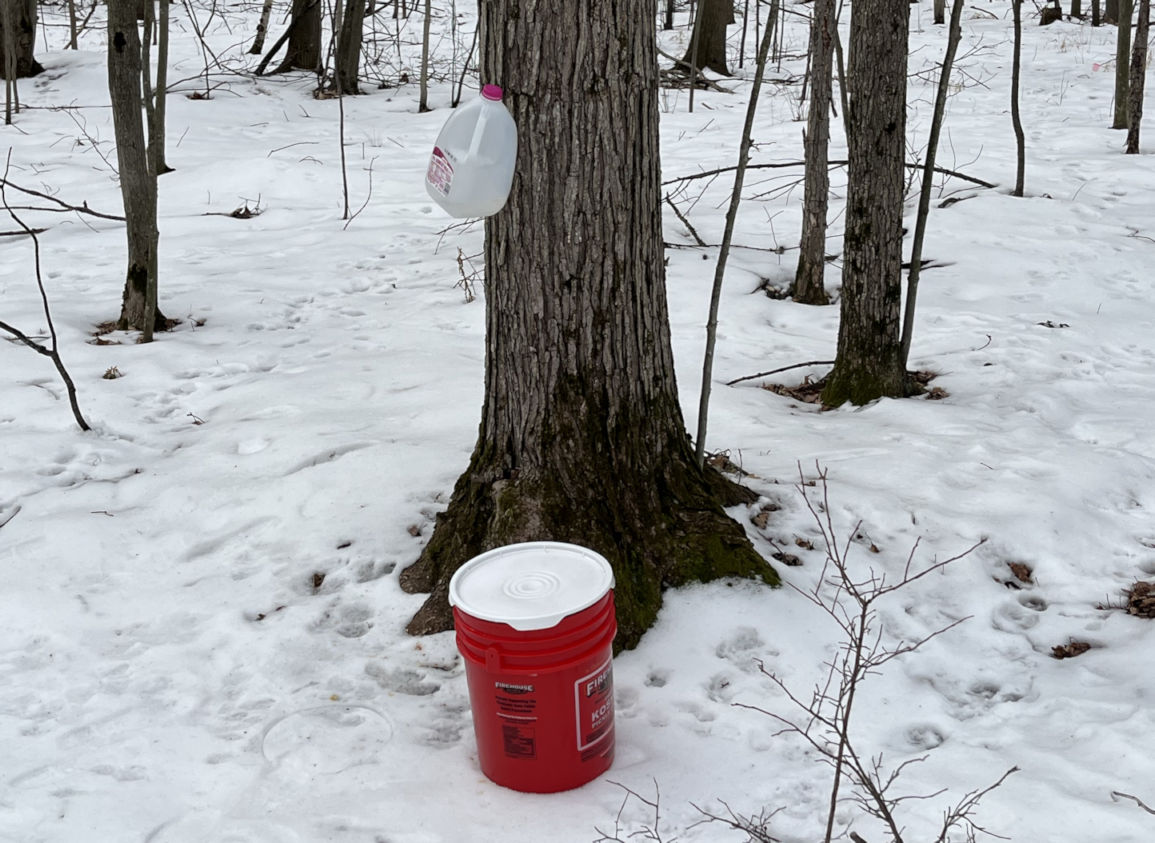
Sap buckets used during collection of maple sap for syrup making.
American Chemical Society | Industry | Industry Matters Newsletter | Smelly Buckets
Smelly Buckets
Industry Matters Newsletter 24 March 2022
The buckets still smell like vinegar. The buckets we use to collect maple sap every spring still smell. They’ve been washed repeatedly and used for years, yet they still retain the distinctive odor of acetic acid.

Sap buckets used during collection of maple sap for
syrup making.
Maple syrup production is largely my wife’s activity. Maple syrup production gives Erin a chance to dust off her chemistry expertise. She, too, is a PhD chemist. She carefully tracks temperature and sugar concentration as she completes the boil-down. It takes about 40 gallons of sap to get a gallon of syrup. Buckets store the gallons and gallons of sap syrup making requires.
Going to the local home center and purchasing an orange, blue, or green bucket isn’t prudent. The HDPE pails sold there aren’t approved for food contact. Skeptics will no doubt question whether a food contact-approved bucket and a utility bucket are different, other than in the higher cost for food grade. For years, I purchased used buckets from a local bakery. They smelled of chocolate or strawberry, smells they would hold for years. Yard use turned them chalky and brittle, faring far worse than a home center bucket. No doubt antioxidants, flame retardants, and UV stabilizers present in the home center buckets are withheld from those intended for food contact.
Our sap buckets are used pickle buckets from a local sub
shop. Freshly used pickle buckets smelling of acetic acid is not surprising. The
human nose is sensitive to acetic acid in the
low part-per-million range. The lingering smell after repeated washings with
soapy water and years of use is more of a surprise. It is also raises questions
about recycling.

The waste reduction hierarchy showing differentiation
between recycling and down-cycling.
I encountered our stinky buckets soon after reading a
recent International Pollutants Elimination Network (IPEN) report with the
ominous title “How
Plastics Poison the Circular Economy”. The ominous title accurately reflects
the ominous conclusions it contains. It addresses consumer goods, not food-grade
materials contact. The report concludes plastic additives, such as flame
retardants, antioxidants, and
PFAS, are getting into recycle streams.
They are ending up in products where they don’t belong, imperiling users.
There are several versions of the
waste reduction hierarchy. Buying used buckets saved me money while allowing
me to feel virtuous. Using an item
again and again for the same use—reuse—is more virtuous than recycling.
Recycling describes when the item is remanufactured from the same material. I
favor a distinction between recycling, where the material is returned to the
same use, and downcycling, where collected material is remanufactured into
something else of lower value. Turning milk jugs into park benches, just as an
example, would be downcycling. Making milk jugs from used milk jugs after
reprocessing is recycling.
Returning polymers to the same use in food contact
applications is a particular challenge, exemplified by my smelly buckets. I know
there is contamination. I can smell it. Acetic acid is smelly, but not
particularly harmful. The worry is dangerous and odorless compounds, and there
are many.
Many are working to let food contact polymers be recycled
back to food contact applications, but I remain uneasy. I can’t help but worry
about plastics used with pesticides and other toxic materials being mixed into
plastic used for food contact. Encountering acetic acid smells in the sap
buckets reinforces my concerns about mechanical recycling for food contact, for
packaging things I’m going to eat. The IPEN report extends that concern to
things that don’t touch food, but that I could touch.
About a year ago, the
FDA revised its guidelines
for inclusion of recycled content in food contact. The FDA is responsible for
establishing acceptable levels of things that can be in food, and stuff that
touches food. The FDA determines how much
rodent filth, mammalian excreta, and insect larvae can be in food. I’m happy
they’re looking, a bit unhappy the answer they come up with isn’t zero. The FDA
levels reflect that zero isn’t practical for rodent filth and mammalian excreta.
It’s come to the same conclusion for contaminants in recycled plastic. Zero
isn’t a realistic option in the eyes of the FDA. Levels are set where there is
unlikely to be harm. The FDA plays the odds. The smell of the sap buckets is
troubling, yet the syrup comes out great with nary a whiff of vinegar. Uneasy as
I am, playing the odds on food contact has worked out OK in my household’s syrup
production.
The quest for ever and ever higher levels of recycled
content is putting recycled material into more and more things. Testing for all
detrimental additives or contaminants is hard, bordering on impossible, as the
IPEN report details. There are so many possibilities. As we play the odds, we
have to hope the odds are in our favor.